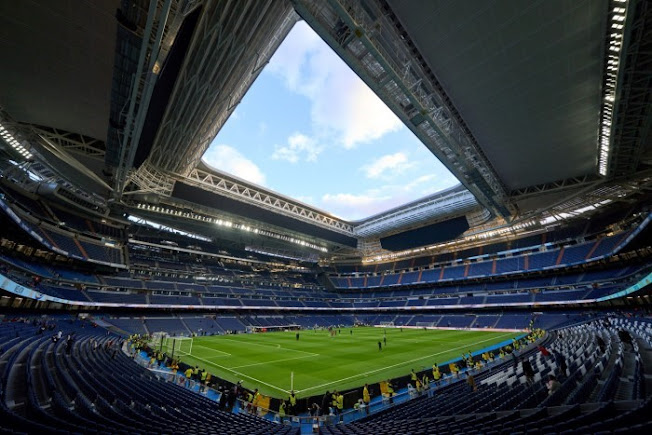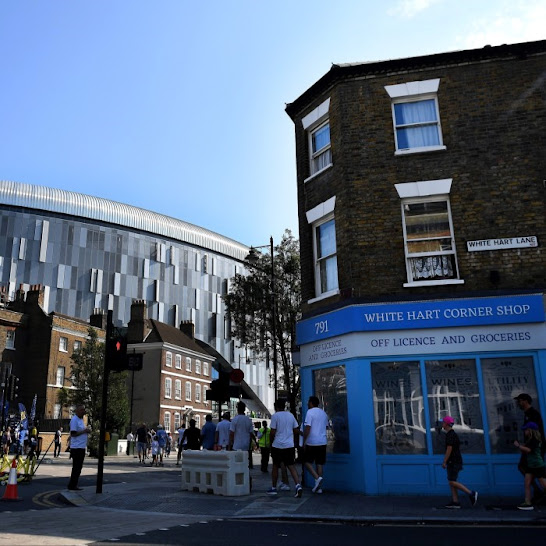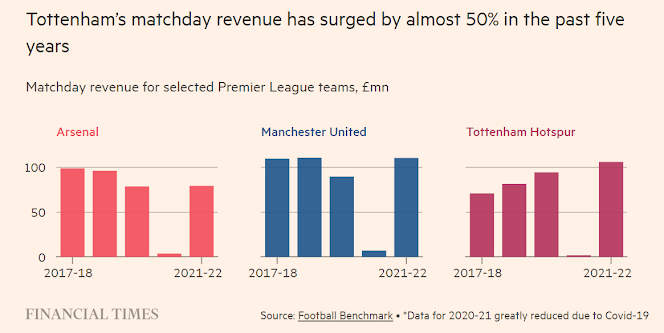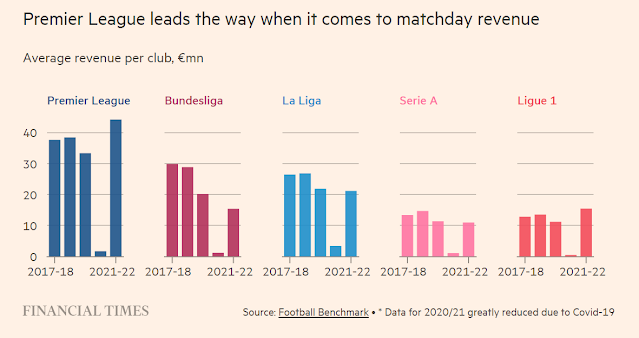The European football clubs turning stadiums into cash cows
Clubs are racing to transform their venues into entertainment destinations, but competing is costly and not without risk
Josh Noble and Samuel Agini in London
 Football stadiums across Europe are seeking to boost commercial revenue by hosting other live events, including Taylor Swift concerts © FT montage/Getty Images
Football stadiums across Europe are seeking to boost commercial revenue by hosting other live events, including Taylor Swift concerts © FT montage/Getty ImagesWhen work is finally completed on the four-year renovation of Real Madrid’s iconic Santiago Bernabéu stadium early this year, it will boast two important new buttons.
One triggers the new retractable roof, able to close in just 15 minutes, that will protect future concert goers from the elements as they enjoy top international music acts. Taylor Swift is booked to play in May.
The other button begins the five-hour process that splits the stadium’s football pitch into six sections and sends it to a vast underground storage space, where light, temperature and humidity controls provide optimum conditions to maintain the grass regardless of what is happening overhead.
All of this is part of the club’s €1.2bn renovation project, which includes restaurants that can serve thousands of people, a skywalk with views across Madrid and a newly expanded museum that is expected to increase visitors from 1.5mn a year to 2mn.
Museum revenue is projected to hit €50mn as a result, similar to the amount some clubs in Spain’s top tier earn from their broadcast rights.
 Real Madrid’s Santiago Bernabéu stadium. As a result of a deal agreed by the club last year with a US investment fund, the venue will also host music and other live events © Angel Martinez/Getty Images
Real Madrid’s Santiago Bernabéu stadium. As a result of a deal agreed by the club last year with a US investment fund, the venue will also host music and other live events © Angel Martinez/Getty ImagesBut Real Madrid is not alone.
With most TV deals negotiated at league level and new regulations that link spending to income, top clubs across European football are raising billions of euros, dollars and pounds for stadium redevelopment with the aim of creating a more diverse pool of cash flow.
The result is akin to an arms race, as owners seek to outdo each other with high-tech, adaptable venues that can grab a slice of the booming market for live music, host lucrative sporting events such as boxing and NFL games, and create a thriving food, beverage and retail business that can compete with neighbouring high streets.
Even better for clubs, institutional investors and commercial banks have been lining up to finance it all.
Several top European clubs are at some stage of upgrading or replacing their stadiums in an effort to keep up.
Inter Milan, AC Milan and Roma are all finalising designs for new facilities, Paris Saint-Germain, Chelsea and Manchester United are weighing up whether to upgrade or replace their cramped or ageing homes, while Barcelona recently raised €1.5bn from the US bond market to pay for a major overhaul of its Camp Nou stadium.
The pressure to compete in the stadium wars is stretching the finances of some clubs, which usually have to cover the mammoth cost of construction themselves.
But some within the industry argue that failing to diversify their home grounds is equally something they cannot afford in the long run.
“The concept is clear,” says one senior club executive working on a major stadium project.
“Convert a football stadium that gets used 25 days a year into a multipurpose entertainment venue that’s busy every day of the year.”
The Spurs model
For now, the gold standard in European football grounds is the Tottenham Hotspur stadium in north London, a £1bn construction project completed in 2019.
Its impact on the club’s finances has become increasingly clear as the effects of the pandemic have faded.
Previously, the average fan would spend less than £2 inside the ground on a typical match day, but now that figure is about £16, thanks to new facilities including the longest bar in Europe and an on-site microbrewery.
Capacity has gone up from 36,000 at the club’s previous home of White Hart Lane to 62,000.
 Tottenham’s new stadium was built on land adjacent to its previous home of White Hart Lane © Harriet Lander/Copa/Getty Images
Tottenham’s new stadium was built on land adjacent to its previous home of White Hart Lane © Harriet Lander/Copa/Getty Images The stadium hosted Beyoncé last May as part of her Renaissance world tour © Kevin Mazur/WireImage/Parkwood
The stadium hosted Beyoncé last May as part of her Renaissance world tour © Kevin Mazur/WireImage/Parkwood“We had been operating with one of the smallest stadia in the Premier League and, consequently, lower match day revenues — in what is a fiercely competitive environment,” says Daniel Levy, chair of Tottenham Hotspur, in an email to the Financial Times.
“An increased capacity stadium was critical to meeting demand from fans unable to get access . . . and driving greater match day and non-match day revenues to reinvest in the football side.”
The new stadium — built on land adjacent to White Hart Lane — has opened the door to a broad range of other events that have helped to push commercial income up from €117mn in 2018 to €215mn in 2022.
Last year, Tottenham hosted US singer Beyoncé for five nights on her global Renaissance tour, two NFL matches, as well as rugby games and heavyweight boxing bouts.
Money brought in from football has gone up too.
Match day income is up from €85mn in 2018 to €125mn last season, according to Deloitte, partially due to the addition of premium hospitality such as The H Club offering private members cuisine from celebrity chefs and The Vault, a place where they can store their whisky and fine wines.
An executive at a rival club described the stadium as a “work of art” that had inspired owners across Europe to reassess their own facilities, and focus much more on the fan experience.
“We can’t treat football fans as a captive audience.
They do have choice.
They will come to the game, but they will spend their money in a local pub and restaurant if you’re not providing good enough quality,” says Christopher Lee, managing director of the Europe, Middle East and Africa business at stadium designer Populous.
Other clubs are following suit.
In Barcelona, the club’s redevelopment project, which has been almost a decade in the making, is finally under way.
Once finished, the total capacity at Camp Nou will only rise slightly to 105,000, but an extra ring of VIP seats will be added, as will a roof, a new third tier of general admission seats, and a 360-degree screen.
More work will take place outside the stadium, where a new building will house the museum and club shop, alongside a revamped Palau Blaugrana, a space that will hold 15,000 people for concerts and other sport, such as basketball.
Spanish clubs will also need to invest heavily in preparation for the 2030 World Cup.
La Liga’s investment deal with private equity firm CVC Capital Partners included carve-outs from the league’s spending rules to encourage clubs to put money into stadium infrastructure instead of blowing it all on players.
La Liga expects the deal to help unlock as much as €1.8bn in investment.
Milos Nenadovic, club infrastructure consultant at La Liga, says the goal is to give fans a reason to arrive before the game and increase the amount of money they spend once there.
Work at the top Spanish clubs has left their Italian counterparts racing to catch up. The two Milan teams share the San Siro, which was completed in 1926 and then renovated ahead of the 1990 World Cup.
The fierce rivals have explored building a new venue together, but recently announced separate plans to build their own stadiums each with capacity for about 70,000 fans.
Both would be some way south of Milan city itself.
In Italy, the problems with infrastructure are acute.
Serie A was the top league in the world in the 1990s, but has since seen its position slip, in large part due to a lack of investment.
It now generates less broadcast income than top leagues in England, Spain and Germany, and recently concluded a domestic TV deal at a lower price than its last contract.
Club executives and owners, including a growing band of professional investors, see new stadiums as key to getting the league back on track.
“Italy is super interesting because the infrastructure has held back huge clubs with massive fanbases and international appeal, which is why we’re seeing international capital move in,” says Lee, who helped design Tottenham’s stadium and is working on stadium projects at both Inter Milan and Roma.
“They are ultimately very undervalued assets.
The stadium is the one thing that flips that.”
Despite the advantage that comes with lucrative Premier League TV rights, English clubs are not immune from the need to update facilities.
Manchester City, ranked by Deloitte as the club with the highest revenue in football, is feeling the pressure to keep up with Europe’s top clubs.
It is planning to add about 7,000 seats to the Etihad, its home ground, but is also building a hotel, a museum and a new 23,500-capacity music space — the Co-op Live arena — on its campus in east Manchester that will host the likes of Nicki Minaj, Eric Clapton and Barry Manilow when it opens in April.
 Construction work on the Co-op Live arena, which is due to open this spring. The space will house a hotel, museum and music venue near Manchester City’s Etihad home ground © Toby Melville/POOL/AFP/Getty Images
Construction work on the Co-op Live arena, which is due to open this spring. The space will house a hotel, museum and music venue near Manchester City’s Etihad home ground © Toby Melville/POOL/AFP/Getty ImagesRoel De Vries, chief operating officer of the group that owns Manchester City, says the club needs to increase stadium revenue “if we want to stay competitive in the world of football and be in the top group when it comes to performance”.
“We cannot easily expand the stadium beyond 60,000,” he says.
“So then we have to figure out, ‘How can we squeeze a lot more out of the stadium?’”
Lure of long-term financing
Much inspiration for the current trend of investment has come from the US, where sports stadiums are often part of a much bigger entertainment complex designed to generate returns seven days a week.
Owners have spent billions of dollars on new facilities for their baseball, basketball and NFL teams, although the model in the US is distinct because franchises can uproot themselves and find new homes.
Cities and states then compete to attract teams by offering to finance or underwrite the costs of new stadiums, with taxpayers often footing the bill.
Although the American funding set-up is hard to replicate, the broader idea of creating diversified real estate businesses with a sports team at the centre is increasingly taking hold.
“There’s the building and how that building generates revenue,” says Irwin Raij, co-chair of law firm Sidley Austin’s sports and entertainment division.
“Then there’s the other part, which has become very fashionable in the US, of owners saying: ‘I want to control the real estate around the building.’”
It is no coincidence that many of the big projects under way are happening in tourist centres. London, Paris, Rome, Milan and Barcelona are all in the top 10 most visited cities in Europe, with Madrid also in the top 15.
Owners see the opportunity to turn football stadiums into attractions in their own right — with stadium tours for football fans and other activities for those who are not.
Tottenham will add a Formula One-branded electric karting track this year, part of a 15-year contract with the motorsport operator.
While football teams are seen as relatively risky borrowers — clubs often pay specialist lenders interest rates of well over 10 per cent — stadiums are seen through a different lens.
Owners will often split the business into a company that owns the club and another that owns the stadium, or a “stadco”.
Stadcos have a far lower risk profile, similar to a power station or wind farm, according to bankers, because they generate long-term, predictable returns that are not so beholden to the team’s performance on the pitch.
While relegation from a top league would push a club’s broadcast income down dramatically, ticket sales and corporate hospitality tend to be sticky in comparison.
Despite enduring its worst ever start to the season, French club Olympique Lyonnais was recently able to complete a €320mn refinancing of its stadium at a fixed interest rate of 5.8 per cent.
The design of a new stadium can have a significant impact on how it is financed.
Anything that brings in visible and reliable future income — such as hospitality boxes — can be borrowed against, often at relatively low rates.
Much of the cost of rebuilding Wembley Stadium in London was paid for through a long-term hospitality contract with sports agency IMG.
At Tottenham, hospitality guests now account for about 13 per cent of those attending matches, partly due to rising demand from wealthy people keen to enjoy a premium match experience rather than corporate clients.
Other clubs have turned to the handful of big investment banks that work on stadium project finance, such as JPMorgan and Japan’s MUFG, or have brought in new shareholders.
Sir Jim Ratcliffe’s deal to buy 25 per cent of Manchester United included a further $300mn investment dedicated to the stadium.
Bankers say some clubs are still able to get long-term financing for as little as 2 percentage points above the base rate, thanks to multiyear contracts such as stadium naming rights or advertising.
Another boost could come if the US Federal Reserve follows through on signals that it will begin cutting rates this year.
“In 2024, the wind is behind our sails. Everyone believes interest rates will go down,” says Greg Carey, global co-head of sports franchise at Goldman Sachs.
“People are getting more comfortable that inflation is under control, and we’re feeling very good about the projects coming on board.”
The less predictable income — a Taylor Swift concert, for example — then becomes an upside for the club.
Hosting a single night of live music from premium artists such as Rihanna or Lady Gaga can bring in as much as €4mn, according to industry executives.
Barcelona was able to borrow the €1.5bn it needs for its project from the bond market in April, even as the club grappled with overstretched finances and high levels of debt.
Real Madrid tapped US investors through private placement, securing long-term financing when interest rates were still close to zero.
Then last year it agreed a deal with US investment fund Sixth Street, which paid €360mn in return for the rights to host music and other live events inside the Bernabéu through Legends, the firm’s events business.
But getting projects over the line is easier said than done — and is not without financial risk.
Building in European city centres is expensive and slow, while planning permissions are often hard, sometimes near impossible, to come by.
Italy has had to change planning laws to make stadium investment easier.
More than a year after their £2.5bn takeover, Chelsea’s US owners are still grappling with whether to attempt a big renovation of Stamford Bridge to increase the 40,000 capacity stadium, or explore an alternative site elsewhere in west London — one of the world’s most expensive real estate markets.
The current stadium is hemmed in by train lines, tightly restricting what can be done.
Although clubs have a range of financing options once a stadium is finished, most must bear the burden of construction directly — typically through standard commercial lending.
That leaves the club exposed to rising building costs, delays and, potentially, higher borrowing costs.
“Until that stadium opens you need to make sure you build it on time and at cost,” Carey says.
“Mitigating construction and completion risk is the biggest risk these clubs face.”
The price of construction has soared since the pandemic as the economic rebound pinched global supply chains.
The headline price of Everton’s new stadium, for example, has jumped to at least £760mn, adding to the club’s serious and mounting financial problems.
While some clubs may try to lock in a fixed-price contract for building work, construction companies are increasingly wary of committing to anything when prices for all things — from labour to materials to energy — are so unpredictable.
For those yet to break ground, the halcyon days of locking in cheap, long-term financing may have passed.
“Timing is everything,” says Levy, the Spurs chair.
“We simply wouldn’t be able to do what we did if we were doing it today.”



0 comments:
Publicar un comentario